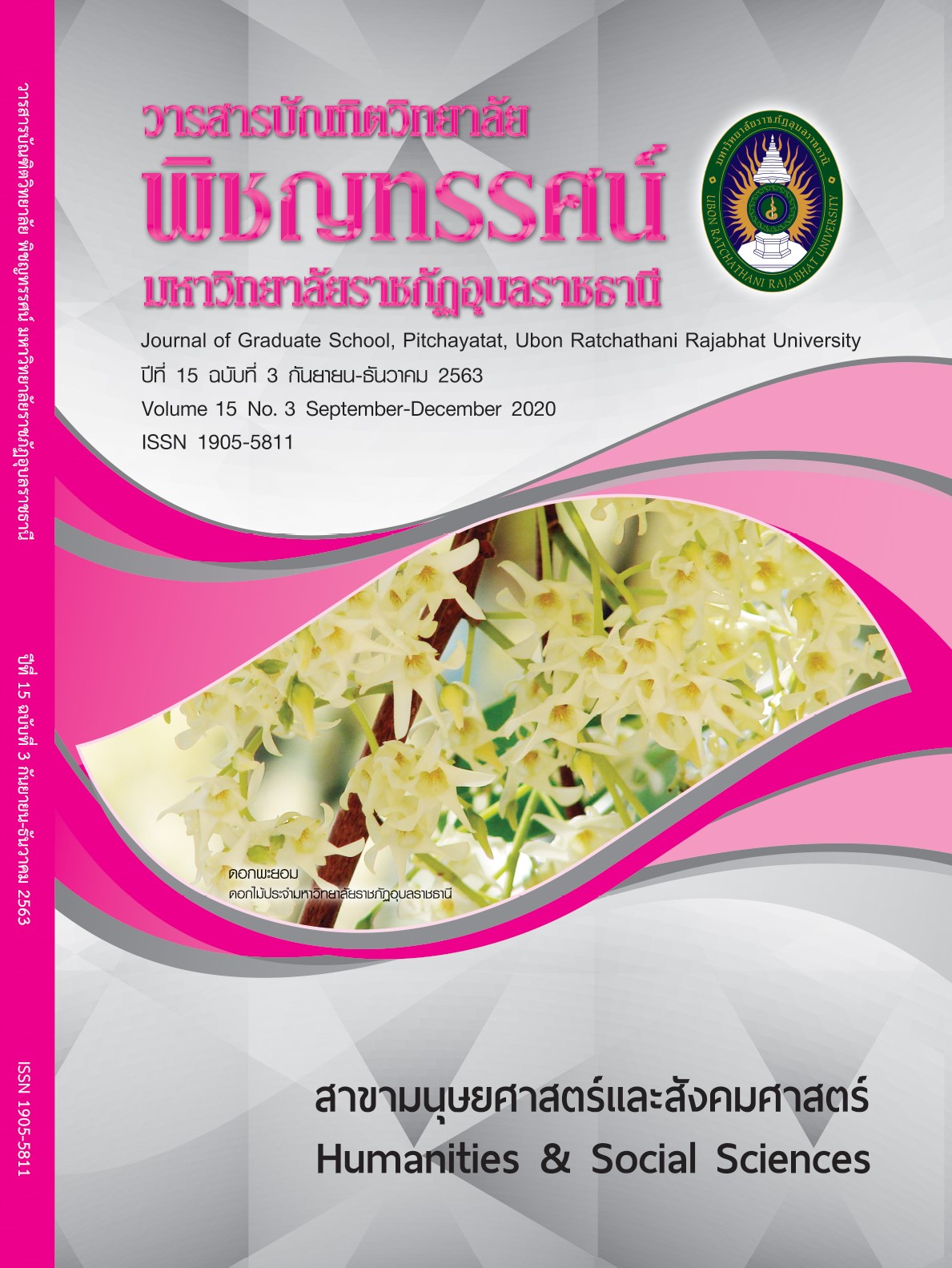รูปแบบและแนวความคิดในการสร้างสรรค์นาฏยศิลป์ชุดชีเทลส์ ผ่านกระบวนการสร้างสรรค์โดยใช้แนวคิดนาฏยศิลป์หลังสมัยใหม่
คำสำคัญ:
การสร้างสรรค์นาฏยศิลป์, กระบวนการ, นาฏยศิลป์หลังสมัยใหม่บทคัดย่อ
งานวิจัยนี้มีวัตถุประสงค์เพื่อค้นหา 1) รูปแบบในการสร้างสรรค์นาฏยศิลป์ชุดชีเทลส์ โดยใช้แนวคิดนาฏยศิลป์หลังสมัยใหม่ และ 2) แนวคิดที่ได้รับภายหลังจากการสร้างสรรค์นาฏยศิลป์ชุดชีเทลส์ มีการเก็บรวบรวมข้อมูลในรูปแบบวิจัยคุณภาพ โดยการสำรวจข้อมูลเชิงเอกสาร การสัมภาษณ์ผู้ที่เกี่ยวข้องกับงานวิจัย สื่อสารสนเทศ การสังเกตการณ์ การสัมมนา และประสบการณ์ส่วนตัว ผ่านกระบวนการวิเคราะห์ สังเคราะห์สู่การสร้างสรรค์ผลงานนาฏยศิลป์ที่ได้รับการคัดเลือกสู่การแสดงระดับนานาชาติ 3 ครั้ง
ผลการวิจัยพบว่า
รูปแบบการสร้างสรรค์ การแสดง 7 องค์ประกอบ ได้แก่ การออกแบบบทการแสดง การคัดเลือกนักแสดง การออกแบบลีลานาฏยศิลป์การออกแบบเครื่องแต่งกาย การออกแบบเสียง การออกแบบพื้นที่การแสดง และการออกแบบแสงและได้แนวคิดในการสร้างสรรค์ภายหลังจากการสร้างสรรค์ 5 แนวคิด ได้แก่ สิทธิเสรีภาพของผู้หญิง นาฏยศิลป์หลังสมัยใหม่ แนวคิดสัญวิทยา แนวคิดและทฤษฎีทางด้านศิลปกรรม และการสร้างสรรค์การแสดงที่เป็นศิลปะเพื่อศิลปะ ได้ดำเนินการประเมินด้วยการส่งการแสดงชิ้นนี้เข้าสู่เทศกาลนาฏยศิลป์ในระดับนานาชาติพร้อมได้รับการคัดเลือกเข้าร่วมการแสดงอันเป็นการประชาสัมพันธ์รูปแบบนาฏยศิลป์หลังสมัยใหม่ในประเทศไทย และเป็นการเผยแพร่องค์ความรู้อันเป็นประโยชน์ต่อผู้ที่มีความสนใจศึกษาสร้างสรรค์นาฏยศิลป์ในรูปแบบหลังสมัยใหม่ต่อไป
เอกสารอ้างอิง
กุลพล พลวัน. สิทธิมนุษยชนในสังคมไทย. บริษัท กานดาพร็อพเพอร์ตี้ จำกัด และบริษัทในเครือ: กรุงเทพฯ, 2543
ดาริณี ชำนาญหมอ. การสร้างสรรค์นาฏยศิลป์เพื่อผู้หญิงกับการยุติความรุนแรง. วิทยานิพนธ์หลักสูตรปริญญาศิลปกรรมศาสตรดุษฎีบัณฑิต จุฬาลงกรณ์มหาวิทยาลัย, 2557.
นราพงษ์ จรัสศรี. ประวัตินาฏยศิลป์ตะวันตก. กรุงเทพฯ: สำนักพิมพ์แห่งจุฬาลงกรณ์มหาวิทยาลัย, 2548.
นราพงษ์ จรัสศรี. นาฏยศิลป์สร้างสรรค์ (สัมภาษณ์). ศาสตราจารย์ ประจำภาควิชานาฏยศิลป์ คณะศิลปกรรมศาสตร์ จุฬาลงกรณ์มหาวิทยาลัย, 7 กุมภาพันธ์ 2560
ทิชา ณ นครและคณะ. ผู้หญิงกับรัฐธรรมนูญ: บันทึกการเดินทางสู่ความเสมอภาค. กรุงเทพฯ: บริษัท พี.เพรส จำกัด, 2545.
พรสวรรค์ สุวรรณธาดา. “แม่พลอยกับเฟมินิสม์,” มนุษยศาสตร์ สังคมศาสตร์. 28, 3 (กันยายน-ธันวาคม 2554): 51-72.
ราชบัณฑิตยสถาน. พจนานุกรมฉบับราชบัณฑิตยสถาน พ.ศ. 2542. กรุงเทพฯ: นานมีบุ๊คส์พับลิเคชั่นส์, 2546.
วิรุณ ตั้งเจริญ. “ลัทธิหลังสมัยใหม่ ศิลปะหลังสมัยใหม่,” วารสารราชบัณฑิตยสถาน. 27, 2 (เมษายน-มิถุนายน 2545): 330-341.
สิริธร ศรีชลาคม. การสร้างสรรค์นาฏยศิลป์ร่วมสมัยร่วมกับการฉายภาพสำหรับการแสดง: มาย แท็งก์ (My Tank). วิทยานิพนธ์หลักสูตรปริญญาศิลปกรรมศาสตรดุษฎีบัณฑิต จุฬาลงกรณ์มหาวิทยาลัย, 2559.
สุภางค์ จันทวานิช. การวิเคราะห์ข้อมูลในการวิจัยเชิงคุณภาพ. พิมพ์ครั้งที่ 11. กรุงเทพฯ: สำนักพิมพ์แห่งจุฬาลงกรณ์มหาวิทยาลัย, 2556.
อรพิมล ทองทิพย์. รูปแบบการสร้างสรรค์นาฏยศิลป์ (สัมภาษณ์). นักศึกษาสาขาวิชานาฏยศิลป์ วิชาเอกนาฏยศิลป์สากล คณะมนุษยศาสตร์และสังคมศาสตร์ มหาวิทยาลัยราชภัฏบ้านสมเด็จเจ้าพระยา, 30 เมษายน 2562.
ดาวน์โหลด
เผยแพร่แล้ว
รูปแบบการอ้างอิง
ฉบับ
ประเภทบทความ
สัญญาอนุญาต
บทความทุกเรื่องได้รับการตรวจความถูกต้องทางวิชาการโดยผู้ทรงคุณวุฒิภายนอกอย่างน้อย 2 คน ความคิดเห็นในวารสารบัณฑิตวิทยาลัย พิชญทรรศน์ มหาวิทยาลัยราชภัฏอุบลราชธานี เป็นความคิดเห็นของผู้เขียนมิใช่ความคิดเห็นของผู้จัดทำ จึงมิใช่ ความรับผิดชอบของบัณฑิตวิทยาลัย มหาวิทยาลัยราชภัฏอุบลราชธานี และบทความในวารสารบัณฑิตวิทยาลัย พิชญทรรศน์ มหาวิทยาลัยราชภัฏอุบลราชธานี สงวนสิทธิ์ตามกฎหมายไทย การจะนำไปเผยแพร่ต้องได้รับอนุญาตเป็นลายลักษณ์อักษรจากกองบรรณาธิการ






